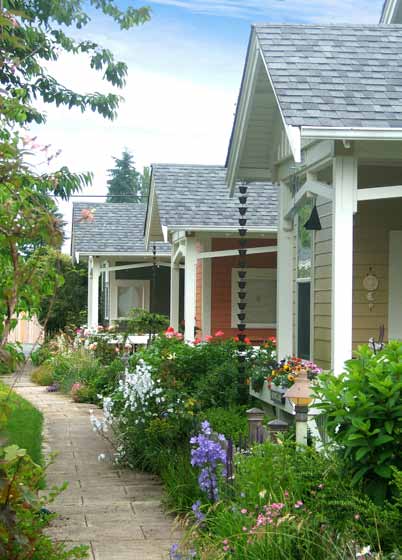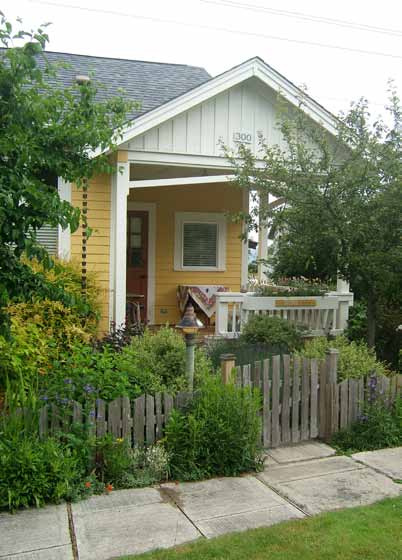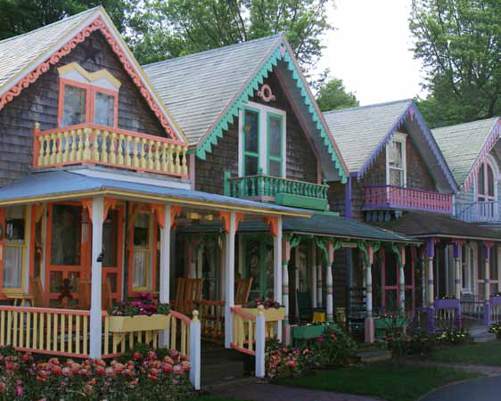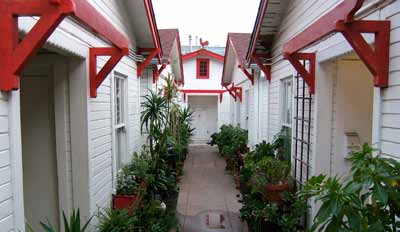The Small House Book (7 page)
Read The Small House Book Online
Authors: Jay Shafer

housing, and all of this is kept far from restaurants, office buildings and shop-
ping centers, which are all kept separate from each other.
With the dispersal have come mandatory car ownership and the end of pe-
destrian life as we once knew it. Where no worthwhile destinations can be
easily reached on foot, there are no pedestrians, and where there are no
pedestrians, there is no vitality.
This separation has simultaneously brought about an increase in the per-
ceived need for ultra-autonomous houses. The idea that a house should con-
tain everything its occupants could ever possibly need and then some is cer-
tainly not a new one, but it has achieved unprecedented popularity as houses
have become increasingly remote from the services they traditionally relied
upon. It now seems that every new residence must contain not only its own
washer, dryer, dishwasher, high-speed internet access and big-screen home
entertainment center, but enough kitchen, bathroom, dining and living space
to serve as a nightclub for forty. The needs fulfilled by the corner grocery and
local bar in our older neighborhoods are now assumed by 700 cubic-foot re-
frigerators and spacious, walk-in pantries. The resources currently required
to support several million personal outposts cannot be sustained.
54
Densities Too Low
Myths about high-density housing abound. It is widely believed, for example,
that higher population densities necessarily increase congestion and strain
infrastructures. This just simply is not the case. The congestion myth and the
fear it inspires stem largely from some very real conditions that exist in our
everyday world. Wherever a design does not accommodate for the number
of people and the type of activities that occupy it, there will be overcrowding.
But, just as with a house, the solution is not necessarily more space; it is usu-
ally better design.
The goal of design is the same for neighborhoods as it is for houses. Good
community design has to meet our needs without far exceeding them. The
suburbs fail on both these counts. People require open space; while the
‘burbs do offer it on an excessive scale, the space is seldom useful. We
inhabit outdoor space in specific ways, and the gaps left over between build-
ings and roads are seldom sufficient to accommodate our specific activities.
The assumption that arbitrary swatches of pavement and bluegrass can well
serve our outdoor requirements is mistaken. Such uninspired places rarely
get used because they provide no sense of place or purpose.
High-density development is particularly conducive to comfortable outdoor
environments. Providing enclosure without confinement is key. Consider ar-
chitect Ross Chapin’s Third Street Cottages in Langley, Washington. It is a
“pocket neighborhood,” comprised of eight, 975-square foot cottages and a
shared workshop, all encircling a community garden. Eleven parking spaces
have been provided out back. A footpath connects the houses and frames
the common garden at center. A strong sense of enclosure is provided by the
surrounding cottages and reinforced by a low, split-cedar fence separating
55
the tiny private garden of each home from the shared one. This idyllic setting
seems to hug without squeezing too hard. It is twice as dense as zoning nor-
mally allows for the area, and yet, there is not a trace of crowding.
Elfreth’s Alley in Philadelphia offers another example of congestion-free,
high-density development. The community was built before zoning laws were
enacted. Elfreth’s Alley was, in fact, established over 300 years ago and has
been inhabited ever since. At about 20 feet wide with 25-foot-tall houses on
either side, this development falls well within the parameters of the recom-
mended building height-to-road width ratio. It is host to one-way automobile
traffic, the residents of its 38 row houses, and thousands of tourists enjoy-
ing the all-too-rare experience of a place designed for people rather than
cars. On this narrow, cobbled road flanked by brick, stone and foliage, it is
easy to feel at home if only because it all makes perfect sense. There are
no strange codes at work and no inexplicable abyss. It is not crowded, and
it is not sparse. Like Third Street Cottages, Elfreth’s Alley is exactly what it
needs to be and nothing more. In each of these places, thoughtful design
with particular attention to proportion and scale has been employed to make
an environment where serenity and vitality coexist. Each should be a model
for those designers and lawmakers who have a hand in our future.
56

Third Street Cottages on Whidbey Is.
57

Third Street Cottages on Whidbey Is.
58

Elfreth’s Ally in Philadelphia
59
Teaching By Example
Embracing less in a culture founded on the precept of more is counter-cul-
tural, but it need not be self-consciously so. To do what we know to be right
takes effort enough. There is no need to waste our much-needed energy on
actively trying to change this spendthrift society. The tangible happiness of a
life well lived is worth a thousand vehement protests.
Magazines, television and billboards incessantly insist that the cure for what
ails us will be revealed by earning and spending more and increasing square
footage. But the security and connectedness we seek are unobtainable so
long as we continue to surround ourselves with these symbols of security
and connectedness. Our desire for that which pretends to be success and
our fear of not having it bar us from feeling genuinely fulfilled. Happiness lies
in understanding what is truly necessary to our happiness and getting the
rest out of the way.
Simplicity is the means to understanding our world and ourselves more clear-
ly. We are reminded of this every time we pass by a modest little home. Oc-
casionally, between the billboards, a tiny structure reveals a life that is unfet-
tered by all of the excesses. Such uncomplicated dwellings serve to remind
us of what we can be when our striving and fear are abandoned. Each person
who chooses to live so simply inadvertently teaches the virtue of simplicity.
In a society as deeply mired in over-consumption as our own, embracing sim-
plicity is more than merely countercultural; it can, at times, be downright scary.
We are in many ways a herd animal, and to take the path less traveled requires
courage. We are living in a system that, if left to its own devices, would have us
in debt up to our eyeballs and still clamoring to purchase more things than we
60
could use in a thousand lifetimes. Simplification requires that we consciously
resist this system and replace it with a more viable one of our own making. For
some of us, it requires that we either break laws or expend the time and mon-
ey required to change those laws that currently prohibit an uncomplicated life.
In any case, anyone who sets out to create such a life should know that he
or she is not alone. Though our current system discourages (even prohib-
its) such freedom, we are all, on some deeper level, familiar with our own
need for simplicity. Order is a human concept that expresses an inherent
human need. On at least the most intuitive level, we all see the beauty in
a well-made, small dwelling because the necessity such a structure ex-
presses resonates with the necessity within each of us. The fear that these
little places sometimes inspire is not really so much one of lower proper-
ty values; it is the fear that these simple dwellings may inadvertently tell
us something important about ourselves that we are not ready to face.
61

Trinity Park, MA
62

